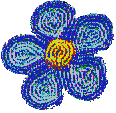

SEED BEADING TECHNIQUES
Page Buttons |
|---|
|
Double-needle applique is the beading technique that Maude Kegg, Mille Lacs Ojibwe elder, uses for most of her beadwork, at least in part. Her 1982 museum bandolier appliques all beads of the pattern, and the solid white field, on the straps and pouch, which has woven beadwork tassels.
Enough beads are put on the beading thread to close each ring (which is done with the beading thread, as shown). The beads are then whipped down, usually with a whipstitch over the bead thread between every bead. There's a limit to the size of circular patterns you can make, that depends to some extent on the relative diameter and heights of the beads. Sooner or later the rings can't form smooth circles any more. No amount of care or bead sizing can defeat this; it is caused by the fact that pi (relationship of a circle's radius to its circumference) is an irrational number, while the numbers of beads in any ring (or along some radii) is not only rational but integer (whole or counting number)! Eventually, as circular rosettes get larger, the numeric irrationality catches up, and makes it almost impossible to keep successive rings lying flat.
Most often, peyote beadwork is joined in a circle to form the hollow "woven" cylinders of seed bead earrings, or long hollow ropes for neck medallions -- sometimes left hollow, but often beaded around a rope. It's also done to make covers for cigarette lighters, as well as to ornament shakers, fans and dance paraphernalia. Peyote beading goes fast, and you don't need to carry around a lot of items other than beads, a supply of thread, and the hairlike needles used with the smaller-hole beads. It makes an especially fine showing when the old-style cut glass beads are used. The best of these are still made in Czechoslovakia and (once again) are being imported to be sold via specialty dealers in Native crafts materials. For quite a few years, you couldn't get them, and some people picked apart older items made with that type of bead to make new things. Now they ar radily available, in extra-fine and ordinary sizes, and many colors,
As the diagram shows, the method is to pull 4-8 beads on a loop tightly down to the material's surface, either running a holding stitch part-way into leather, or all the way through fabric. Some beadworkers also go through the end bead with a lock-stitch, from which the next loop of beads will start, so that if one pulls loose, the others won't be affected. The tight, flat loops of lazy-stitch beads are about as long as dyed, flattened quills, which are sometimes combined with seed beads -- the very old, traditional, and the newer beads that came as trade goods.
The diagram shows how it works. The bead string, containing 1 fewer beads than there are weft threads (including th edges which actually are usually 2 threads each edge) is run under the weft, and pushed up with the finger. The needle is then pushed back through the row, so the thread goes above the weft threads. There are 2 threads, one below and one above the weft that go through the holes in each row. Together they hold the rows tightly in place between the weft threads, and each weft thread spreads the beads slightly, holding them in columns the length of the weaving. There is no real limit to this length, you roll up finished work and continue weaving until ready to finish off a length. There are many different ways to finish a woven strip's end. The most usual holds the weft threads with some knots that leave even ends, for a belt, hatband, or necklace. Danglers of various kinds are added if the woven strips are to be tassels, as on Maude Kegg's bandolier bag. |
|---|
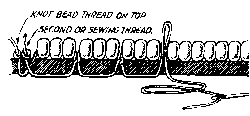 Double needle means there are 2 threads in use. On the bead thread are lined up a number -- usually not too many -- of beads which are laid down on the fabric where they go in the pattern, which is being made by one continuous thread making sinuous curves that give the patrn its dynamic. The second needle holds the whipping thread, which whips over the beading thread between each bead -- or every few beads in for faster, sloppier beadworkers (like me).
Double needle means there are 2 threads in use. On the bead thread are lined up a number -- usually not too many -- of beads which are laid down on the fabric where they go in the pattern, which is being made by one continuous thread making sinuous curves that give the patrn its dynamic. The second needle holds the whipping thread, which whips over the beading thread between each bead -- or every few beads in for faster, sloppier beadworkers (like me).
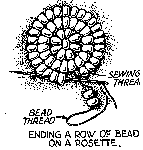 The easiest pattern for the novice beadworker to learn applique on is the circular rosette. The turtle you see above right was the second thing I made (a small pouch to hold tobacco). I gave it away, so while I don't know if my adopted niece still has it, it exists very vividly in my mind. Computer-beading of it for these pags was comparatively simple, because the entire pattern is one circular rosette, with dark green beads to make the turtle. The dimensions of the squat cylinder which is a seed bead's shape will determine exactly how many beads form a smooth circle around the center. By varying the colors -- counting or copying a pattern, but usually by eye if doing your own -- the circular rosette can make a variety of patterns, often radial ones, for neck medallions and other small circular objects.
The easiest pattern for the novice beadworker to learn applique on is the circular rosette. The turtle you see above right was the second thing I made (a small pouch to hold tobacco). I gave it away, so while I don't know if my adopted niece still has it, it exists very vividly in my mind. Computer-beading of it for these pags was comparatively simple, because the entire pattern is one circular rosette, with dark green beads to make the turtle. The dimensions of the squat cylinder which is a seed bead's shape will determine exactly how many beads form a smooth circle around the center. By varying the colors -- counting or copying a pattern, but usually by eye if doing your own -- the circular rosette can make a variety of patterns, often radial ones, for neck medallions and other small circular objects.
 Peyote beadwork is a technique that young beadworkers find easy to learn. Not that anyone would find it easy to make a big peyote bead cover like this one, with its complex pattern, smooth shape over the many diameters of the wine bottle. This tight, smooth covering won Lorene Thomas, Pyramid Lake Reservation Paiute, second prize at the 1977 Intertribal Indian Ceremonial at Gallup, NM, and is now in a California museum (Coe collection).
Peyote beadwork is a technique that young beadworkers find easy to learn. Not that anyone would find it easy to make a big peyote bead cover like this one, with its complex pattern, smooth shape over the many diameters of the wine bottle. This tight, smooth covering won Lorene Thomas, Pyramid Lake Reservation Paiute, second prize at the 1977 Intertribal Indian Ceremonial at Gallup, NM, and is now in a California museum (Coe collection).
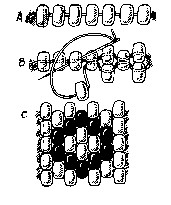 Peyote beadwork gets its name because it has been very widely used for a long time to cover handles of fans, rattles, sticks and other items used in rituals of the Native American (peyote) Church. At the right, this single needle single-thread technique is shown. Going back through alternate beads to form the next row creates a diamond-shaped pattern of the solid finished beads.
Peyote beadwork gets its name because it has been very widely used for a long time to cover handles of fans, rattles, sticks and other items used in rituals of the Native American (peyote) Church. At the right, this single needle single-thread technique is shown. Going back through alternate beads to form the next row creates a diamond-shaped pattern of the solid finished beads. 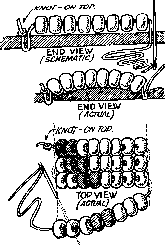 Lazy squaw stitch has come to be regarded as a no-no description, because of the denigratory white man's distortion of the Ojibwe word for woman, ikwè, into the pejorative universal "squaw". Nowadays, it's just called Lazy stitch. It is used on Plains beadwork, and by most everyone to bead Plains-style moccasins, buckskin dance dress yokes and similar items.
Lazy squaw stitch has come to be regarded as a no-no description, because of the denigratory white man's distortion of the Ojibwe word for woman, ikwè, into the pejorative universal "squaw". Nowadays, it's just called Lazy stitch. It is used on Plains beadwork, and by most everyone to bead Plains-style moccasins, buckskin dance dress yokes and similar items.
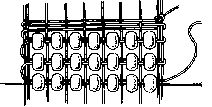 Loom-Woven beadwork is the last common modern seed bead technique. A variety of different kinds of looms are used, mostly home made. Though loom-woven beadwork can be fairly wide -- some bandoliers were made that way, straps are 6 inches wide, and pouch squares a foot or so square -- it is mostly used for tassel strips, belts, hatbands, and necklace supports for medallions, narrower and done with a needle and small loom (sometimes a couple of combs) to hold the weft threads. For fancy powwow outfits, though, woven beadwork is frequently used for wide arm and legbands.
Loom-Woven beadwork is the last common modern seed bead technique. A variety of different kinds of looms are used, mostly home made. Though loom-woven beadwork can be fairly wide -- some bandoliers were made that way, straps are 6 inches wide, and pouch squares a foot or so square -- it is mostly used for tassel strips, belts, hatbands, and necklace supports for medallions, narrower and done with a needle and small loom (sometimes a couple of combs) to hold the weft threads. For fancy powwow outfits, though, woven beadwork is frequently used for wide arm and legbands.